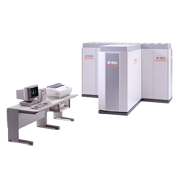Fujitsu released three new model groups (M-1900, M-1700, and M-1500), following the M-1800 model group, under the generic name “new M-1000 series.” Fujitsu announced the model groups in May 1994, which were positioned as global servers that incorporated client-server designs with conventional mainframe functionality.
Features of the new M-1000 series:
- (1) Dramatic cost-performance improvement and broad performance lineup
- Cost performance was two to five times better than that of the M-700 series. The M-1900 model group covered a performance range of about 11 times from smallest to largest machine; the M-1700 model group, about a 7-fold range; and the M-1500 model group, about a 10-fold range.
- (2) Enhanced support of client-server features
- Standard equipped with a LAN controller
- Supplied with PowerAIM, a new middleware package with client-server technology
- (3) Data compression features and the new OCLINK*1 optical channel
- (4) (M-1500 model group) Made more affordable with CMOS*2 and COF*3 technologies
- The M-1500 model group used 0.5-micron CMOS technology and high-density MCM.*4 COF technology allowed the mainframes to house 3.5-inch magnetic disks.
- *1. OCLINK: Optical channel link. Fujitsu’s own storage-connection interface standard for high-speed data transfers with storage units. The standard’s maximum transfer speed was 17 MB per second and storage units could be located as far as 9 kilometers away.
- *2. CMOS: Complementary metal oxide semiconductor.
- *3. COF: Convert storage facility. An emulation unit built in the CPU that converts disk storage formats. With the unit in place, the CPU saw new compact magnetic disk units (which used a fixed-length block format) as the magnetic disk units (which used a variable length record format) used on mainframes. In this way, COF allowed Fujitsu to use cheaper and newer disks in its M-1500 model group.
- *4. MCM: Multichip module. A module that mounts multiple LSI chips on a thin-film ceramic substrate. Performance gains can be realized from the MCM’s high-density mounting. The MCMs used with the M-1500 model group cut the mounting area to one-sixth of the area needed otherwise and doubled the machines’ performance.
| Model name | 10R | 10S | 10 | 20 | 30 | 40 | 25 | 35 | 45 | 65 | 85 |
|---|---|---|---|---|---|---|---|---|---|---|---|
| Introduced | May 1994 | ||||||||||
| Relative performance* | 0.6 | 0.8 | 1 | 1.8 | 2.6 | 3.3 | 1.8 | 2.6 | 3.3 | 5.3 | 6.8 |
| No. of CPUs | 1 | 2 | 3 | 4 | 2 | 3 | 4 | 6 | 8 | ||
| Main memory capacity | 512 MB max. | 1024 MB max. | 2048 MB max. | ||||||||
| System memory capacity | 8 GB max. | ||||||||||
| Channels (no. of OCLINK channels in total) |
64 max. (48 max.) |
128 max. (112 max.) |
256 max. (224 max.) |
||||||||
*Taking the performance of the M-1900/10 as the baseline.
| Model name | 4 | 6 | 8 | 10Q | 10R | 10S | 10 |
|---|---|---|---|---|---|---|---|
| Introduced | May 1994 | ||||||
| Relative performance* | 1 | 1.5 | 2.1 | 3.0 | 4.0 | 5.3 | 6.8 |
| No. of CPUs | 1 | ||||||
| Main memory capacity | 512 MB max. | ||||||
| System memory capacity | 8 GB max. | ||||||
| Channels (no. of OCLINK channels in total) |
32 max. | 64 max. (48 max.) |
|||||
*Taking the performance of the M-1700/4 as the baseline.
| Model name | 2 | 4 | 6 | 8 | 10 | 20 | 30 | 40 |
|---|---|---|---|---|---|---|---|---|
| Introduced | May 1994 | |||||||
| Relative performance* | 1 | 1.3 | 1.7 | 2.3 | 3.1 | 5.8 | 8.0 | 9.6 |
| No. of CPUs | 1 | 2 | 3 | 4 | ||||
| Main memory capacity | 124 MB max. | 252 MB max. | ||||||
| Channels | 12 max. | 28 max. | ||||||
*Taking the performance of the M-1500/2 as the baseline.
The specifications above were correct at the time the products were announced. Some specifications were later revised due to product upgrades.


